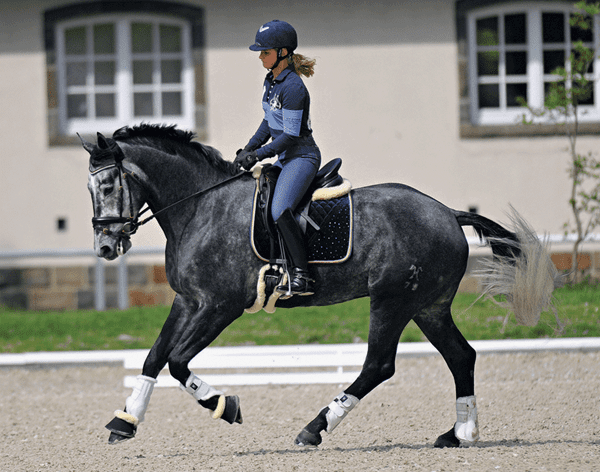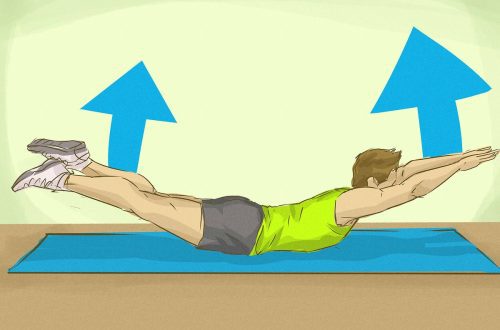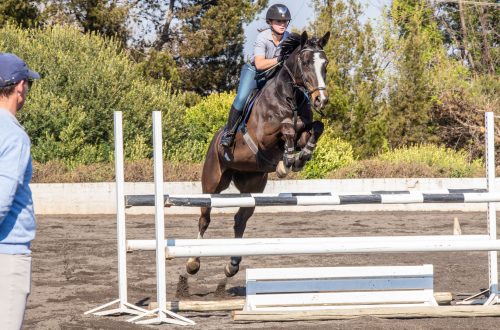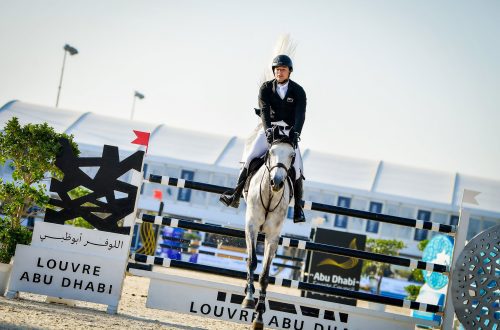
Young horses: work on balance and rhythm
Young horses: work on balance and rhythm
Preparation is everything!
In order to develop a harmonious partnership with the horse, the rider must ensure that all his work is fully justified at every stage of training – from the green horse to the big prize competing in international tournaments. By continually strengthening the foundation and making sure the horse easily understands the rider’s controls, without hesitation, fear or tension, the rider helps the horse build confidence, trust in himself and in him. We need to know for sure that our big prize horse will always be able to understand us and respond easily and subtly. We want to prepare him physically and mentally to respond to our requests in a calm, clear and balanced way, without hesitation or resistance – this is what we have been working on from the moment we first get to know a young horse.
Gently starting to work under the saddle after training in the hands, the horse spends 45 minutes a day in training, moving at a walk, trot and canter. It’s best to start with a walk, but sometimes a young horse can react badly and become disobedient, and we can start with a canter to help him release tension, relax his breathing, and begin to focus on the rider. We must “read” our horse and work with it as circumstances require. The rider at this stage must be very careful in how he asks the horse for anything – it would be too easy to break and achieve everything quickly, but with force.
Let the horse enjoy the job
A young horse should move vigorously, his body should be elastic and his neck should be long. What for? Because this position allows the young horse not to lose confidence while he is learning (!) to use his body, developing self-carrying (independent balance) from the beginning of his training, and it allows harmoniously developing all the necessary muscles from the very beginning.
To become an athlete, a person must go to the gym five days a week to gradually develop his body with the right exercises. The same gradual and steady process should be the training of a young horse, to which we have added a new task – to find balance with the rider on the back.
Good balance and rhythm can be developed by any horse
It is of the utmost importance that the rider/trainer recognize that all horses are individuals and training must be strictly individualized. Each horse has its own posture, its own characteristics of the trot, needs a certain contact, which may be different from the contact needed for another horse. Some horses have naturally long necks, so they carry them high in work. Some have a natural rhythm; some horses need our help, we have to help them develop this rhythm with extreme care.
Whatever the case may be, we should never force a horse to develop what we consider to be a “good” rhythm if that would cause him to rush, run with a sagging back and a trailing hindquarters. In this case, the horse will never be able to find its balance and rhythm. By using force to create an artificial “frame” we can destroy the horse’s confidence and balance. Over time, by causing the horse to resist demands that he is unable to fulfill, we will make him stiff, tight, crooked and heavy on the bit. Instead of a willing and cooperative partner who moves forward in a smooth and balanced manner, the horse may become either passive or resistive, moving either too far ahead or constantly behind the legs. In both cases the rider will perform worse and the work will not be enjoyable for him or the horse.
There is a very thin line between a good rhythm, haste and laziness. The rider must help the horse to know what his good rhythm is by giving him the right signals so that the horse clearly understands his messages. If a young horse has a naturally good rhythm, the rider should not be tempted to try too quickly to ask for more power – the horse may start to rush, lag behind. So we lose its natural balance.
If the horse naturally moves forward well and perhaps even hurries, we try to create a slower rhythm. Many horses trot slowly with short strides. It may seem boring, but it is their natural rhythm. The rider must be very patient and understand that this horse is no worse than other horses. She needs time and she must get it. She will become stronger, she will give us everything she can and, if our training and training are right, she will become beautiful in her own charm. She will develop the right muscles and eventually find her own rhythm. Just try to help such a horse maintain its natural rhythm and balance; do not pressure her, she may want to run away and start to hurry.
Sometimes the horse “jumps” into the trot from the walk, and some riders tend to think that this is disobedience or prejudice. But the horse only shows you that his butt is weak and he cannot push with it, instead throwing his front forward. Sometimes a young horse, during a gallop, begins to lag behind, tosses its head, etc. In each case, the rider must carefully consider whether he is interfering with the balance of the horse by moving it out of line, asking for an exercise that the horse is not yet physically ready to perform..
All aids must be in harmony with the horse’s “engine” to maintain proper forward movement, and each horse has its own distinct engine. It’s like shifting gears in a car: while your hand is looking for the right gear, your feet have to work on the accelerator and clutch pedals independently so that the revs are right and there are no jerks and jumps in motion.
Wrong training cripples the horse
The horses will do their best for us because they are friendly. We have to make sure we don’t ask for too much either, using their body and mind. Sometimes, in order not to destroy balance and rhythm, we must do things that are not written in books, we must worry less about not looking perfect. By focusing on striving for perfection, we can confuse a young horse. We train – we do not earn points in some competition.
The goal of training a horse is not competition. Education in itself is the goal. We want to make a particular horse as flexible and beautiful as possible. We want the horse to develop his own balance and rhythm to the best of his athletic ability, and so we are very careful when working with his frame. We will do a very useful thing for ourselves and for the horse if we study the literature on anatomy and biomechanics, look for information about how the horse moves.
Take the time to look at what a horse does with its hocks, because that’s what it does with its nose. If her nose is behind the vertical, the hocks cannot advance far enough to cover enough ground to create a natural hang. The horse can raise the hocks high, but it is wrong to do so, “losing” the angle of the shoulder. The more experienced horse should raise the knees in a certain way and make a piaffe. The knee joint should be at an angle to the shoulder, and this angle should correspond to the angle of the hip.
Every part of the horse must work together to perform advanced movements. If one part does not work correctly, the whole horse cannot move properly and its back cannot rise properly. Since the back dictates what the legs need to do, if any segment of the spine is blocked, the horse will “miss” something in his movement, his hocks may touch, his strides may become short, the diagonal pairs may become uneven, etc. The horse can move its legs and body, but if it moves when its spine is not connected from the occiput to the tail, the result will be stiffness and tightness, which will lock up other parts of the body accordingly.
The horse becomes empty, wrong muscles develop which affect the skeleton, and soon the rider, instead of developing his young horse, finds himself fighting with him, not understanding why the previously good horse began to resist. He scolds her character, physical shortcomings and weaknesses, looking for ways to solve the problem by cutting her diet or adding supplements to it, changing ammunition, iron, etc.
An “empty” horse is difficult to work with and therefore cannot develop full balance and rhythm on its own. An “empty” horse cannot raise its belly and back. The vertebrae are pinched. But when the horse’s back rises, the vertebrae are exposed. As the back rises, the hips and tail drop lower. This is a frame to strive for!
In a young horse that is being drawn into training, we want to work in longitudinal balance, with a telescopically extended neck, a flexible occiput, nose in front of the vertical, a soft arch of the top line from occiput to tail, and eyes between the point of the thigh and knee, depending on the build. One of the reasons we see horses “wrecked” at a very young age is incorrect initial training that prevents the horse from developing its own balance and rhythm during the delicate stages of development, and/or forcing a young horse to perform advanced movements before he can was physically capable of it.
Incorrect work of a young horse – work behind the vertical, a hard rein pulling back, uneven work (one side works more than the other) – develops curvature and restraint in the horse, which affects the purity of the gaits, the horse’s ability to work at full strength, move forward in balance, carry yourself on your own.
There are other factors that can prevent a horse from working freely, even if the training is correct. They are too often overlooked by riders and trainers. In fact, it is rare to find horses (regardless of their specialization) that do not have any part of the body that hurts. As trainers and riders, it is our responsibility to have knowledge of the biomechanics of horse movement. There are many reasons why a horse cannot move forward freely:
“Adoption” of the snaffle by a young horse
There is a common misconception that a young horse must learn to “take” the bit. It’s not necessary, and we shouldn’t rush her into it. Gradually develop the horse with very simple exercises until he can carry himself and the weight of the rider on his own. A young horse has something to take besides a snaffle.
Forcing a young horse to accept the bit early can cause him to lean on the snaffle and walk on the forehand. A young horse will fall on its front at first until its body becomes stronger and it can no longer carry itself. If we frame the horse, it will not allow him to develop his independent balance or learn to carry himself. In the early stages it is not noticeable, but when work on the lateral movements begins, you will notice how heavy the horse is in the hand, you will see that there is no fluidity of movement.
The horse may go ahead of the snaffle (using the wrong neck muscles) or behind the snaffle (behind the vertical) to avoid pain caused by a strong or inattentive hand. This will stiffen the horse’s spine. She will start cutting corners, rushing into them, falling with her shoulder into the turn, working in circles, will narrow them. The prospects are gloomy – so the horse will not be able to stay in the ranks for a long time. The pressure on the joints, tendons, ligaments, muscles, bones and mind is too strong. Strong contact with the reins also creates problems for a young horse. When the contact is heavy and insensitive, the horse cannot respond. We can see this all too often at higher levels of riding where riders are forced to raise their arms to their chest to “lift” the horse for piaffe and passage. If they lower their arms, the horse’s head and neck will simply fall, because he will no longer feel safe. This reflects a lack of training. We didn’t have to lift the horse with the reins. Contact between the horse’s hands and mouth should be kept to a minimum, and this is what we should strive for from the very beginning when we first start training a young horse: firm but light and yielding contact.
Balance and rhythm of your horse
In the photographs below, we see a horse that has just started working under the saddle and has used the Manolo Menedez method, which involves months of training in the hands to develop balance and strength. The horse works on Lindell’s bitless bridle for the first few months, learning to carry a rider and maintain self-balance without a bit. But she had been introduced to the snaffle earlier as part of a training program.
Before the rider was alone with the horse, there was a transition period in the work, when the horse worked on the cavesson and bridle, and the rider was assisted by an assistant from the ground. At first, the controls were duplicated by both the rider and the helper, then the assistant’s signals were gradually removed until only the rider’s signals remained.
A comfortable posture that allows you to learn to carry yourself under the saddle. The neck is long, the eye is at the level of the hip point, the throat is open.
Mickey gradually lost his balance and raised his head. The rider remained calm and did not interfere, moving the horse forward.
A few steps after Mickey trots in the frame forward-down-out without tension.
Sixteenth canter under saddle, forward movement slightly hesitant. The rider encourages Mickey by moving to a lighter seat.
Seventeenth gallop under the saddle. Mickey is a little wobbly. The rider supports him and encourages him to use his neck as a balancer.
Calm and supportive rider: a confident and calm horse.
Remember that in these early stages of training we are strengthening the body and training the horse’s mind. Never pull her by the vertical, do not scare or pull, so as not to damage her mouth. Riding a young horse behind the vertical is a big mistake. Always in work, including during transitions, the horse must remain in front of the vertical. Without this, true balance and forward movement are unattainable. Developing natural balance and rhythm leads to true collection. A rider on a more experienced horse may also work behind the vertical, mistakenly believing that this rounds the back. You can force the horse’s neck into the desired position, but this will not result in collection. Collection can only come about when the horse has been allowed to move freely, having been taught to carry itself through training that has developed its own balance and rhythm.
The body of the horse in these stages of training should be like an accordion, gathering and stretching with fluidity and ease. Impulse requires a combination of many things – the regularity of the stride, the ability of the rider to use the legs and the reins in a subtle way, the ability to use them gently and harmoniously, picking up and softening. This is a process during which you can find a balance between yourself and the horse.
If you are in tune with your horse’s movement, you are closer to true collection, creating cadence and lightness. This is why developing balance and rhythm in a young horse during these initial phases becomes so important to its ability to move forward on its own. Every step counts. By working with the horse every step, we will be able to reach higher levels with him without losing comfort. If we don’t rush now, we’ll be rewarded later.
The need to correct the muscular corset, curvature, restore independent balance, which we are forced to deal with if the horse has learned in tension, resistance and pain, are much more difficult activities than competent and gradual work with a young horse from scratch, based on its structure, temperament and abilities. We must remember that every time we work incorrectly, we develop muscles that will resist us and damage joints that will fail us when we start working on lateral movements, collection and connection.
Every step we take is either a step towards a stronger, straighter, more balanced, more confident, calmer and better moving horse, or a step towards lack of straightness, unclean gaits, lame ending.
Manolo Mendez with Isabella Dean and Caroline Larruil.(source); translation Valeria Smirnova.
- Black squirrel 9th of June 2018
A very useful article, otherwise they always wrap young horses with all sorts of so-called extras. means ((. Thank you, maybe someone will read and think Answer





